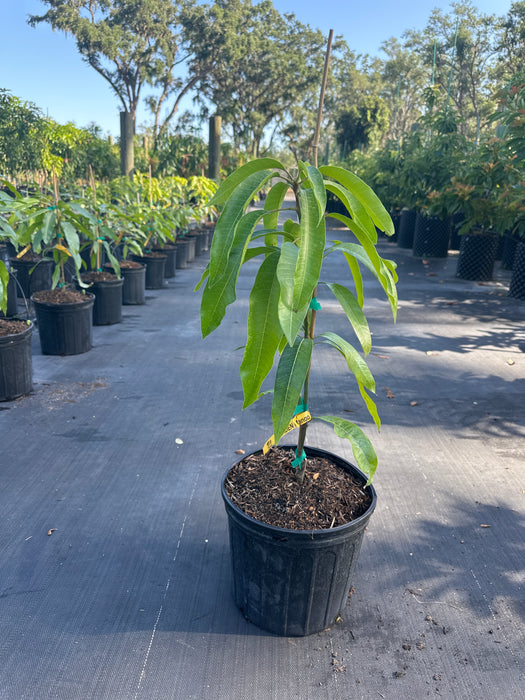
Mango-Haden Tree
Original price
$59.00
-
Original price
$159.00
Original price
$119.00
$59.00
-
$159.00
Current price
$119.00
Taste:
-
The Haden Mango produces large, oval fruits with a sweet, rich flavor and a smooth, fiberless texture.
-
Its taste is vibrant and tropical, blending intense sweetness with subtle citrus and peach undertones, perfect for fresh eating, juicing, or desserts.
-
The flesh is deep orange, juicy, and highly aromatic, making it a classic choice among mango lovers.
Best Growing Environment:
-
Thrives in tropical and subtropical climates with warm, humid conditions, ideally between 75-95°F (24-35°C).
-
Prefers well-draining, sandy loam soil with a pH of 5.5-7.0, enriched with organic matter to support vigorous growth.
-
Benefits from a site protected from strong winds to safeguard its heavy fruit load and delicate flowers.
Botanical Name:
-
Mangifera indica 'Haden'
Common Names:
-
Haden Mango
-
Haden’s Mango
Average Height:
-
Typically grows to 20-30 feet (6-9 meters) in height when planted in the ground, depending on pruning and soil conditions.
-
Can be maintained at 8-12 feet (2.4-3.6 meters) in containers or with regular pruning for smaller spaces.
Growth Rate:
-
Moderate to fast growth rate, adding 1-3 feet (0.3-0.9 meters) per year under optimal conditions.
-
Grafted Haden trees usually begin fruiting within 3-5 years, faster than seed-grown trees.
Sun Requirements:
-
Requires full sun, with 8-10 hours of direct sunlight daily to ensure healthy growth and abundant fruit production.
-
Partial shade can reduce flowering and fruit yield, so a sunny, open location is essential.
Cold Hardiness:
-
Sensitive to cold, with damage to leaves and flowers below 40°F (4°C); severe damage or death below 30°F (-1°C).
-
Best suited for frost-free areas; in cooler climates, grow in containers and bring indoors during cold weather to avoid frost damage.
Water Requirements:
-
Needs regular watering during establishment, about 2-3 times per week for the first 2-3 months, keeping soil moist but not soggy.
-
Once established, water deeply every 7-10 days during dry periods, reducing to biweekly in cooler months to prevent overwatering.
-
Tolerates brief dry spells but produces better fruit with consistent moisture, especially during flowering and fruit development.
Planting Guide:
-
Plant in spring after the last frost in a sunny, well-draining location; dig a hole 2-3 times wider and as deep as the root ball.
-
Mix native soil with 30-40% compost to improve fertility; plant at the same depth as the nursery container, ensuring the graft union is above ground.
-
Water thoroughly after planting and apply a 2-3 inch (5-7 cm) layer of organic mulch (e.g., wood chips or bark), keeping it 2 inches from the trunk to prevent rot.
-
Space trees 20-25 feet (6-7.6 meters) apart for ground planting; for containers, use a pot at least 20 inches (50 cm) wide with drainage holes.
Fertilizing Times and Recommended Fertilizer:
-
For young trees, fertilize every 2-3 months during the first year: early spring (March), late spring (May), summer (July), and early fall (September).
-
Use a balanced, slow-release fertilizer like 6-6-6 or a fruit tree-specific blend (e.g., 8-3-9) with micronutrients such as zinc, iron, and manganese.
-
For mature trees, apply fertilizer 2-3 times per year: early spring (February), early summer (June), and late summer (August), using 1-2 pounds (0.45-0.9 kg) per inch of trunk diameter, favoring high-potassium blends to enhance fruiting.
-
Avoid fertilizing in late fall or winter to prevent tender growth; supplement with chelated iron or magnesium if leaves show yellowing or nutrient deficiencies.
USDA Zone:
-
Thrives in USDA Zones 9b-11 for outdoor planting, where frost is rare or minimal.
-
In Zones 4-9a, grow in containers and move indoors or to a greenhouse when temperatures drop below 40°F (4°C) to protect from frost.


